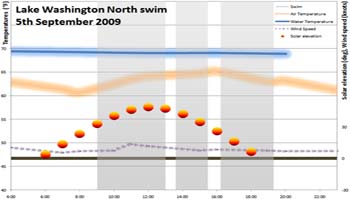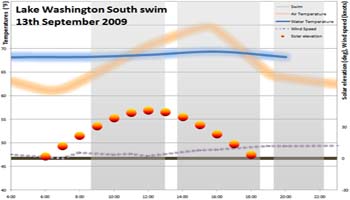Where: I started with swimming long distances in Lake Washington. The Puget Sound is a whole lot harder due to waves, saltiness, and currents. You're generally allowed to swim anywhere on lakes within 50' of the shore or within 25' of a boat, but see below for more detailed laws.
Pace: Take it easy! I do a very slow breast stroke at 1.1 miles per hour including breaks for food and drink. Most serious athletes seem to swim 2.5 mile per hour. The way I see it, most people can walk all day because it's not so tiring. Make your swim not so tiring either, and you'll be able to swim much longer too!


When: In summer I'd start around 10am and finish before sunset. The graphs above show water temperature (steady blue line), and air temperature (orange glowing line), on a cloudy day (left) and sunny day (right). The red dots at the bottom are the sun. Dawn is the very coldest part of the day. The warmth of the sun on your back really makes a big difference.
Stroke: Personally I use breast stroke, but most people use front crawl. The key for long-distance swimming is to be as lazy and efficient as possible. You're at your most efficient when stretched out long. So when you stretch out in your stroke, just hold it for a little longer.
Temperature: The Puget Sound is COLD! In the Sound I wear a wetsuit all year round -- a 4:3 wetsuit, 3mm neoprene gloves and booties (with separate big toe) and hood, and a thick rash guard. In this gear I've been able to swim an hour in Lake Washington every month of the year, and in the Puget Sound from April through to November. Serious swimmers claim that you can train your body to get used to cold water, by lying in an ice bath at home and by doing cold swims, but I've never managed it. Tip: tuck your boots and gloves inside the wetsuit legs and arms to get less water circulation and stay warmer.
Drink: A bottle of Gatorade, tied on a string around your shoulder and dragging along behind you, is great for swims of an hour or more. It's important to get electrolytes from Gatorade or bananas or the like otherwise you'll get cramps. I used to take a camel-pak on my back with water+sugar+salt+lemonjuice, but Gatorade is a better mix, and bottle-on-a-string is easier to swim with than a pack.
Food: Start the swim with some carbohydrates in you. There's a false superstition that if you swim after eating then you'll get stomach cramps. It's false. The real danger is that any food in your stomach will sit there and make you feel nauseous and seasick: while swimming, your digestive system runs at a massively reduced rate.
Currents: You have to deal with currents on the Puget Sound. Once I was 200 yards from a marker buoy. I spent two hours struggling to swim to it but gave up. The tidal current was about 1.1mph. I swim at 1.1mph, or a little more if I make an effort, which is why it was simply impossible for me to make progress. In tidal areas, it's essential to prepare in advance.
Legal: You are allowed to swim pretty much anywhere! ...
Lake Washington is mostly governed by the Seattle Municipal Code. This is friendly
towards swimmers. RCW 35.21.160 and SMC 16.04.075 explain that technically Lake Washington is considered a
"Harbor" of Seattle, and so subject to Seattle harbor laws.
SMC 16.28.010 say that, in a harbor area, swimming is prohibited except (A) in designated swimming areas,
or (B) within 50 feet of the shore or a pier,
or (C) within 25 feet of a vessel that has a PFD for each swimmer.
Seattle lifeguards have a professional duty to "impress upon swimmers" the need to keep the perimeter
of their areas secure. By WAC 352-32-080(3) you’re required to obey the lifeguard if you're using
a designated swimming area -- though not outside it. All of Washington is governed by the Washington Administrative Code.
WAC 352-32-080(2) says "Any person swimming outside the boundaries of a designated swimming area
shall do so at his or her own risk."
Now, if you're swimming along the shore and you want to swim around a designated swimming area, then
the lifeguards inevitably paddle out to tell you you're not allowed to. They're not strictly correct,
but it's courteous to get on shore and walk past the designated swimming areas.
Other areas aren't so friendly to swimmers. In Renton (in particular the Gene Coulon park at the Southern
tip of Lake Washington), you are not allowed to swim within the park boundaries. It's not
clear how far out into the lake the park boundaries extend. In Sammamish lakes, code 7.12.450
disallows you from swimming in their lakes at all except in the clearly marked out swimming areas.
You're allowed to swim within 25 feet of a "vessel". What exactly is a vessel? RCW 79A.60.010 (29)
explains, "'Vessel' includes every description of watercraft on the water, other than a seaplane,
used or capable of being used as a means of transportation on the water. However, it does not
include inner tubes, air mattresses, sailboards, and small rafts or flotation devices or
toys customarily used by swimmers."
Note: WAC 352-32-070 prohibits llamas in designated swimming areas.
Safety: Everyone tells you "always swim with a partner; swimming on your own
is dangerous". I don't see it. Long-distance swimming is often inevitably a solo affair.
What are the real dangers?
Dangers from your own stupidity: Swimming on your own into the middle of Lake Washington
or the Sound is dangerous. I've had boats whizz past me at high speeds, and a sea-plane land
a few yards from my head. You're invisible out there no matter how bright your swimcap. There
is no safe way to swim on your own in the middle of the lake. Eliminate this danger
just by swimming within 50 feet of shore, or dragging a kayak behind you.
Dangers from others: If you stay within 50 feet of shore, you have to watch out for
boats that enter or leave their docks. I think breast stroke is safer than front crawl because
it lets you scan for boats with every stroke. I take a pea-less whistle with me to attract
boaters' attention in case they get to close. I've never felt unsafe or had any close calls.
Danger from events: Cramp? It takes just 30 seconds to swim the 50 feet to shore. A wetsuit
will also keep you afloat. I don't think cramp is a real danger for a solo swimmer. You'll
also learn to avoid cramp anyway through electrolyte intake. Heart attack? I don't see how
swimming would be any more dangerous than a solo hike, or a solo drive through rural roads
at night.
Danger from ignorance: Currents and undertows are obviously dangerous.
You just have to research these before setting out.
Mental preparation: About 1000 years ago, the story goes, Beowulf was being challenged
for the stupidity of his swimming endeavours:
"Are you the Beowulf who took on Breca
in a swimming match on the open sea,
risking the water just to prove that you could win?
It was sheer vanity made you venture out
on the main deep. And no matter who tried,
friend or foe, to deflect the pair of you,
neither would back down: the sea-test obsessed you.
... And Breca outswam you, came ashore the stronger contender."
Beowulf responds:
"Well, friend Unferth, you have had your say
about Breca and me. But it was mostly beer
that was doing the talking. The truth is this:
when the going was heavy in those high waves,
I was the strongest swimmer of all.
Each of us swam holding a sword,
a naked, hard-proofed blade for protection
against the whale beasts. But Breca could never
move out farther or faster from me
than I could manage to move from him.
Shoulder to shoulder, we struggled on
for five nights, until the long flow
and pitch of the waves, the perishing cold,
night falling and winds from the north
drove us apart. The deep boiled up
and its walling sent the sea-brutes wild.
My armor kept me safe when some ocean creature
pulled me to the bottom. Pinioned fast
and swathed in its grip, I was granted
one final chance: my sword plunged
and the ordeal was over. Through my own hands,
the fury of battle had finished off the sea-beast.
In the morning, light came from the east, bright
guarantee of God, and the waves
went quiet; I could see headlands.
I think that mental attitude is the most important part
of long-distance swimming. You have to have a stubborn
streak like Beowulf, and be comfortable with the silence
of your own mind and breathing. I used a SwiMP3
underwater mp3 player for several years, and still do
occasionally, but it's not as effective as silence.